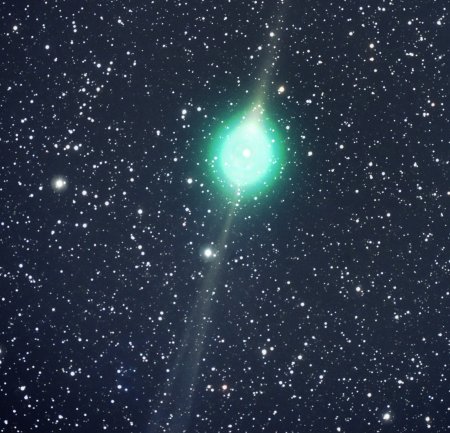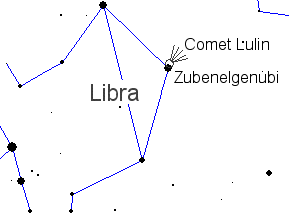On February 24, Comet Lulin will approach a distance of about 60 million km from the Earth, and may be visible in all its glory even to the naked eye. Its green color comes from cyanogen

In 1996, a seven-year-old boy in China looked through the eyepiece of a telescope and saw something that would change his life - Comet Of ornate beauty, bright and puffy with an active tail. At first he thought he had discovered it himself, but he learned that it had the name of two people - Hale and Bopp, who obtained it. But after the disappointment, young Kaunzhi Ye promised that one day he would discover a comet himself. And that day did come.
On a summer afternoon in July 2007, Yeh, now 19 and a meteorology student at Sun Yat-sen University in China, was looking at a black-and-white image of the sky. The photo was taken a few nights before by the Taiwanese astronomer Chi Sheng Lin as part of the "Heaven Patrol" at the Lulin Observatory. Ye's finger moved from point to point and stopped. One of the stars was not a star. It was a comet, and this time he saw it first.
Comet Lulin, named after the observatory in Taiwan where the image was taken, is now approaching Earth. "It is a beautiful green comet that may be visible to the naked eye every day." Yeh said.
Jack Newton photographed Comet Loughlin from the observatory in his backyard in Arizona. Unfortunately my eyes cannot see the comet brighten, Newton said, but my 14 inch telescope photographed it on February 1st.
The comet is making its way to Earth and at its closest point it will be 0.41 astronomical units (about 60 million kilometers) from Earth on February 24, 2009. Estimates today show that its maximum brightness will reach 4 or 5 units, this means that in dark skies in rural areas It will be possible to watch it. No one can say for sure, as this is likely Lulin's first visit to the inner solar system and his first exposure to strong sunlight, so surprises are to be expected.
Lulin's green color comes from its gas. The jets fired from the comet's nucleus contain cyanogen (CN - a toxic gas found in many comets) and diatomic carbon (C2). These two boosters glow green when illuminated by sunlight in the near-total vacuum of space.
In 1910 there was a great public panic when astronomers revealed that the Earth was passing through the cyanogen-rich tail of Halley's comet. It was a false alarm because the thin tail of the comet cannot penetrate the Earth's compressed atmosphere. And even if it penetrated, it didn't have enough cyanogen to cause real trouble. Comet Lulin is less dangerous even than Hubble, at its closest approach it will be about 60 million kilometers from Earth. Harmless.
In order to see Comet Lulin with your eyes, you need to set the clock to three in the morning local time. The comet will rise a few hours before the sun and may be found a third of the way up in the southern sky before dawn. Here are some points you can use to find it

On February 6th (tomorrow night) Lulin will glide near Zubenelgenubi – a double star at the fulcrum of Libra. This double star appears as a single point to the naked eye. Looking through binoculars at this star will reveal Comet Lolwin in nice close proximity.
On the 16th of February, Lulin will pass by Spika in the Toula group. Spica is a magnitude 1 star, and is therefore also visible from the cities. The search eyepiece of the telescope directed to Sika will also capture Comet Lulin in the field of view (sky map).
February 24 - the greatest approach. A special morning. Lulin will be found only a few degrees from Saturn in the group of Leo. Saturn is a prominent planet, and Lollin might look pretty good too. (sky map).
Ye commented that Comet Lulin is impressive not only because of its rare beauty, but also because of the rare way in which it was discovered. "This is a comet that was discovered in collaboration between Taiwanese and Chinese astronomers," he said. "The discovery could not have been made without the contribution of each of the parties from the strait that separates the two countries. Chi Sheng Ling and the other members of the Lulin Observatory team allowed me to get the image I wanted, and I analyzed the data and discovered the comet."
"Perhaps sometime this month, imagines Yeh, another young astronomer will look through a telescope and see Comet Lulin, and feel the same awe I felt when I looked at Comet Hale-Bopp in 1996, and who knows what that will lead to. I hope that my experience will inspire other young people to continue on my path and dream of the stars," Yeh said.

10 תגובות
They said that the color will be green or greenish, you can tell the difference, we are used to seeing light blue or blue like this [at least that's how I am with mine XD]
It's all written there Y'mastolim learn to read ><” most likely at 3 o'clock at night today
Will it be possible to see the comet without binoculars in a way that will make us distinguish it from an ordinary star?
A relic from Krypton?? :0)
When will it be at maximum brightness?
Luke, ask the creationists, they are the greatest experts in probability...
What is the chance that the molecule will be produced randomly..
For creationists, everything is created randomly and the question is one of probability..
What time will the transition be on the specified dates?
What is so complex about the CN molecule?
The fact that organic molecules are quite complex
reaching us from outer space, supports the hypothesis
that the origin of life is somewhere in space.